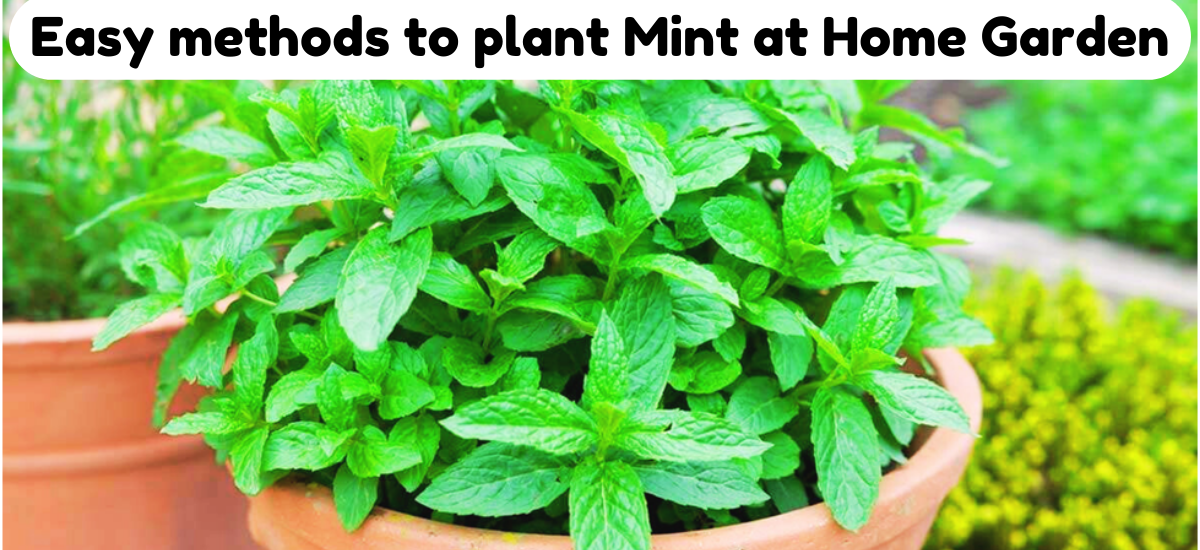Mint is a fragrant herb beloved for its refreshing aroma and culinary versatility. It is surprisingly easy to grow in your home garden. Whether you have a sprawling backyard or a sunny windowsill, a mint variety and method perfectly suits you. So get ready to unleash your inner green thumb and fill your home with the refreshing scent of fresh mint.
Choosing Your Mint Variety:
The first step is to select the mint variety that best suits your taste and space. Here are some popular varieties are
- Peppermint
- Spearmint
- Chocolate mint
- Apple mint
Peppermint
The classic mint flavor is perfect for mojitos, and teas, and adds a zing to savory dishes.

Spearmint
Slightly milder than peppermint, spearmint is ideal for garnishes, salads, and desserts.

Chocolate mint
A delightful surprise, chocolate mint leaves have a hint of cocoa, making them perfect for teas, desserts, and even cocktails.

Apple mint
As the name suggests, apple mint has a subtle apple aroma and flavor, making it a unique addition to fruit salads and cocktails.

Planting Methods
There are two main options for growing mint. First starting from seeds and second using stem cuttings.
Steps to grow mint at home using seeds
You can grow mint using seeds, here are simple steps you can follow:
- Choose a well-draining potting mix or garden soil rich in organic matter.
- Sow the tiny seeds directly onto the soil surface and lightly press them down.
- Cover the pot with plastic wrap or a clear dome to maintain moisture and humidity.
- Place the pot in a warm, sunny location and keep the soil moist but not soggy.
- Seedlings should emerge within 10-14 days. Once they have a few sets of true leaves, thin them out to allow for proper growth.
- Sow the tiny seeds directly onto the soil surface and lightly press them down.
- Cover the pot with plastic wrap or a clear dome to maintain moisture and humidity.
- Place the pot in a warm, sunny location and keep the soil moist but not soggy.
- Seedlings should emerge within 10-14 days. Once they have a few sets of true leaves, thin them out to allow for proper growth.
Steps to grow mint using Stem cuttings
You can grow mint using simple stem cutting you can follow;
- Select healthy stems from a mature mint plant, about 4-6 inches long.
- Remove the lower leaves, leaving just a few pairs at the top.
- Dip the cut ends in rooting hormone (optional but encourages faster rooting).
- Plant the cuttings in individual pots filled with moist potting mix.
- Place the pots in a bright, indirect sunlight location and keep the soil moist.
- New leaves should start growing within a week or two. Once established, pinch off the top leaves to encourage bushier growth.
Mint plant care indoor
While mint loves light and warmth, scorching sunshine can be harsh. Here’s a revised version considering possible issues:
Choose a bright, sunny window
Ideally south-facing in winter and east/west-facing in summer.
Aim for 65°F – 75°F. Warmer temperatures are fine but avoid exceeding 80°F.
Watch for leaf burn if leaves wilt or turn crisp, adjust the pot’s position for shade during peak sun hours.
Avoid drafts and heat sources. Don’t place your mint near radiators, vents, or appliances that emit heat.
Rotate the pot regularly Ensure all sides receive sunlight for even growth.
Tips to grow mint at home
If natural light is limited, invest in grow lights to supplement sunlight for 12-14 hours daily.
This revised version provides more nuanced information to help ensure your mint thrives indoors.
Soil
Well-draining soil is crucial for preventing root rot. Amend your garden bed with compost or organic matter for optimal drainage.
Fertilizer
Feed your mint plant with a balanced fertilizer once a month during the growing season.
Harvesting
Pinch off leaves as needed throughout the growing season. Regular harvesting encourages bushier growth.
Pests and diseases
Mint is generally pest and disease-resistant. However, watch out for aphids and fungal diseases in humid conditions.










